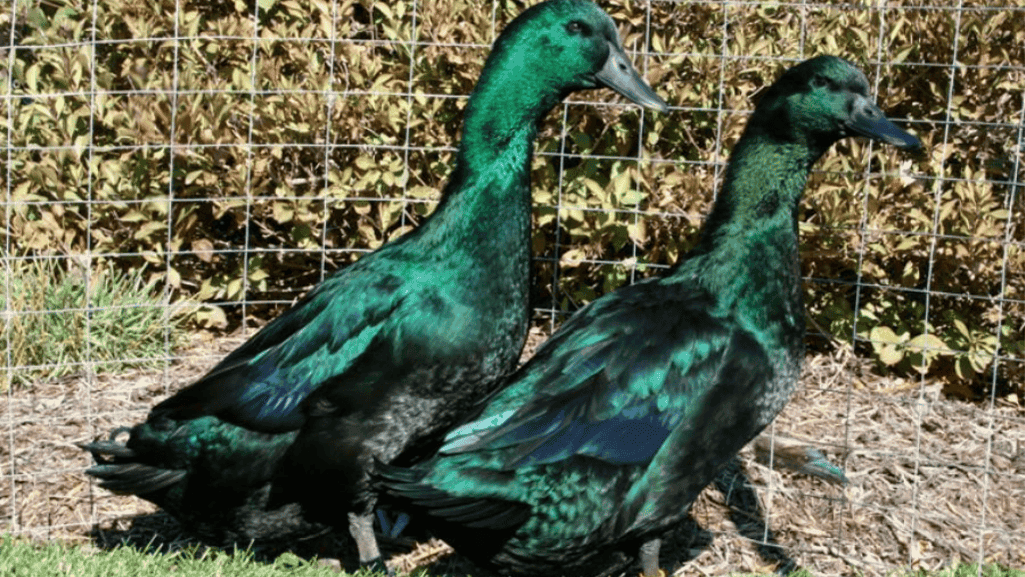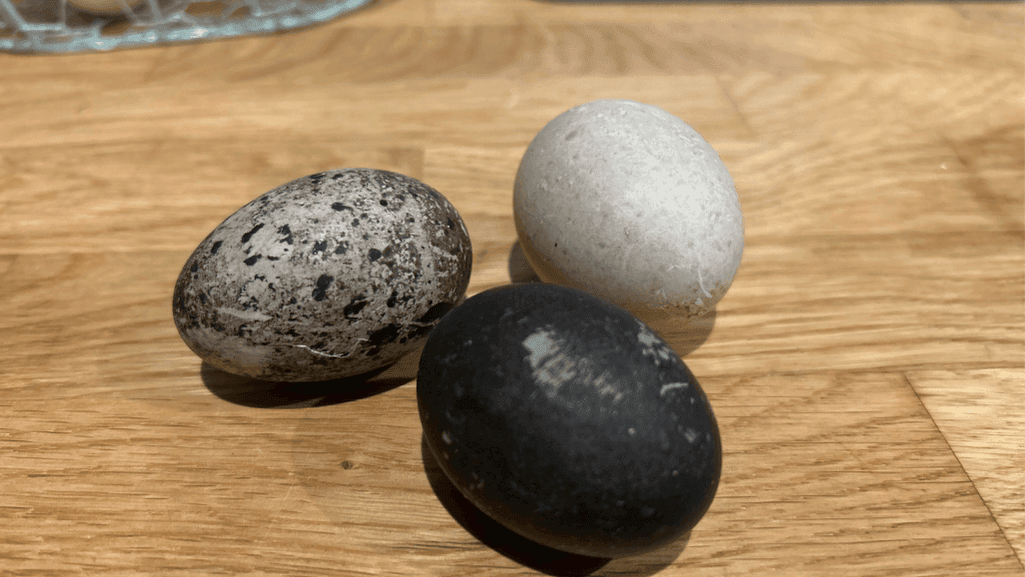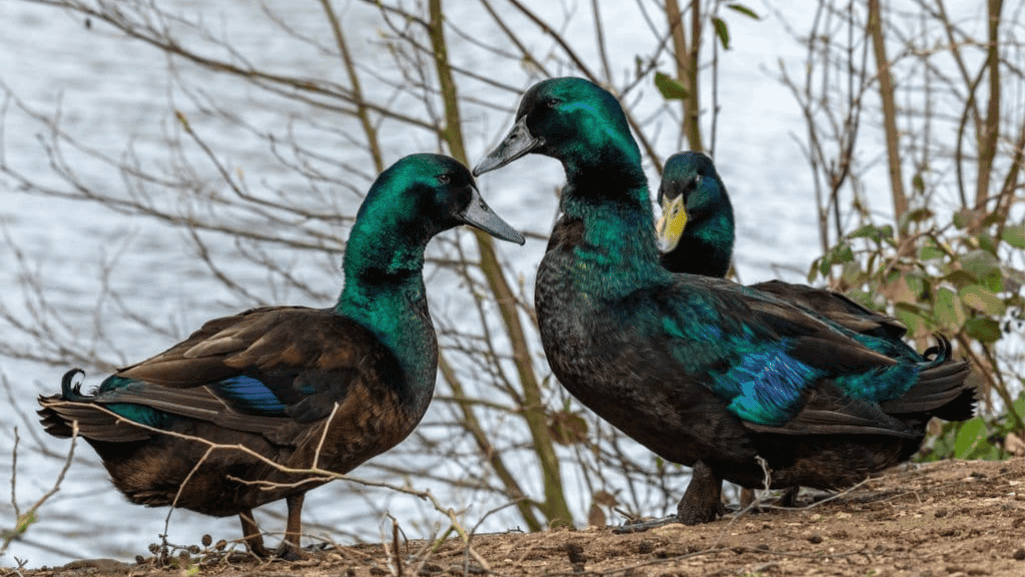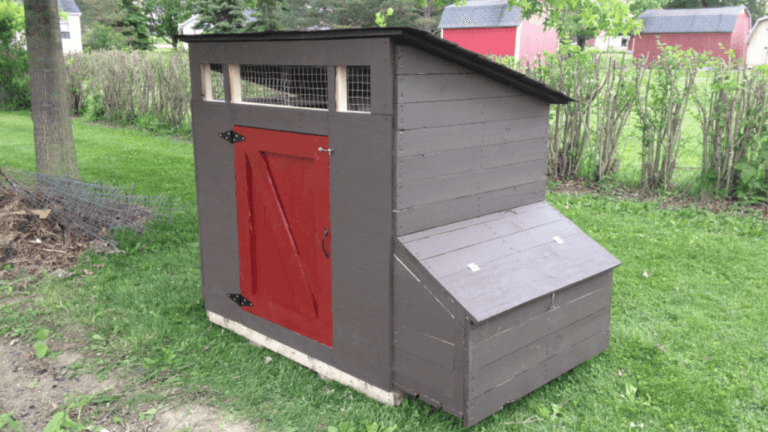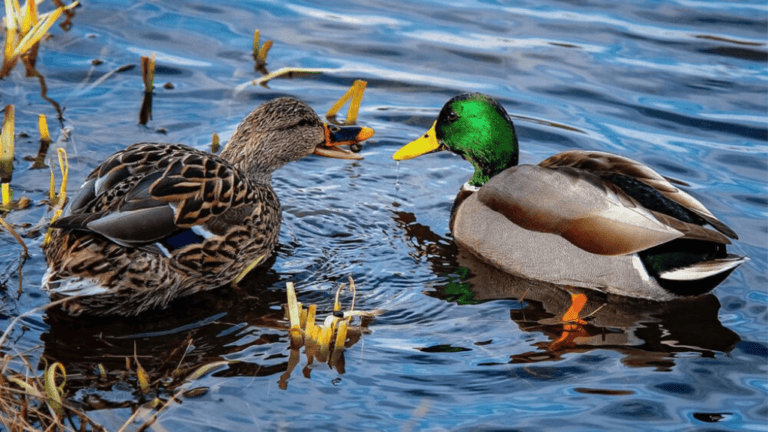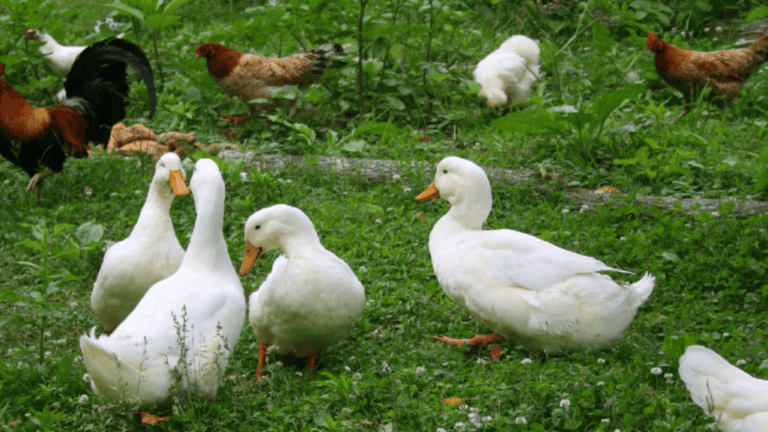Get ready to be amazed by the beauty of Cayuga ducks. They are a stunning addition to any backyard. Their green-black plumage shines with iridescent feathers, creating a mesmerizing sight. As a heritage breed, they add diversity to duck breeds and bring joy to those who love them.
Cayuga ducks are great for both looks and practical use. They are hardy and can live in many climates. This makes them a favorite among duck lovers. By welcoming Cayuga ducks, you join a community that values these amazing birds.
At Ducks New World, we love Cayuga ducks and other waterfowl. We want to teach and inspire people to see their importance. Our goal is to help these birds thrive and continue to amaze us with their beauty.
Key Takeaways:
- Cayuga ducks are known for their striking green-black plumage with iridescent feathers.
- They are a versatile breed, suitable for both ornamental and practical purposes in backyard flocks.
- Cayuga ducks are hardy and can adapt to various climates, making them a popular choice for duck enthusiasts.
- As a heritage breed, Cayuga ducks contribute to the diversity of duck breeds and are valued for their unique characteristics.
- Embracing Cayuga ducks allows enthusiasts to join a growing community passionate about preserving and promoting these majestic waterfowl.
Introducing the Captivating Cayuga Duck
Get ready to fall in love with the Cayuga duck. This breed is a true standout among American ducks. They are not only beautiful but also very hardy, making them great for both new and experienced duck keepers.
The Cayuga duck’s beauty is unmatched. Their black feathers have a greenish sheen that’s mesmerizing. This unique look comes from centuries of careful breeding in Cayuga County, New York. The goal was to create a duck that’s both beautiful and lays lots of eggs.
Although the Cayuga duck’s popularity waned in the late 1800s, efforts to save them have paid off. The Livestock Conservancy has moved them from “threatened” to “watch,” showing growing interest. Today, they are highly valued in poultry farming.
Cayuga ducks are special because they’re good at laying eggs and look great doing it. They can lay up to 150 large eggs a year. Their ability to lay eggs and their hardiness make them a great choice for many farms.
| Characteristic | Description |
|---|---|
| Weight | Males: 8 lbs Females: 7 lbs |
| Egg Production | 100-150 eggs per year |
| Lifespan | Over 10 years with proper care |
| Temperament | Docile and friendly |
Cayuga ducks are not just beautiful and productive. They are also very calm and friendly. Raised from ducklings, they become very docile and are great additions to any backyard. They can handle different environments well, thanks to their downy feathers and body fat.
Starting your journey with Cayuga ducks will be enchanting. They will capture your heart with their beauty and charm. Whether you’re new to ducks or have experience, the Cayuga will become a beloved part of your flock.
Origins and History of Cayuga Ducks
The Cayuga duck has a long history, tied to Native American tribes in New York’s Finger Lakes region. These birds are loved for their beauty and calm nature. They have won the hearts of many, from duck fans to backyard keepers.
Native American Roots
The Cayuga duck’s story starts with the Native American Cayuga tribe. They valued these birds for their meat, eggs, and feathers. The tribe’s bond with the ducks helped shape the breed into what we admire today.
Development as a Breed
When European settlers came, they saw the value of Cayuga ducks. In the early 1800s, farmers worked to improve the breed. It was officially recognized in 1874 by the American Poultry Association.
| Year | Milestone |
|---|---|
| 1800s | Cayuga duck breed developed |
| 1840 | Breed officially named “Cayuga” |
| 1874 | Recognized by American Poultry Association |
| 1890s | Pekin duck surpasses Cayuga in popularity |
In the 19th century, Cayuga ducks were key on New York duck farms. They were valued for their meat and eggs. But by the 1890s, the Pekin duck became more popular, reducing Cayuga numbers. Still, breeders worked hard to keep the Cayuga alive for future generations.
Distinctive Features of Cayuga Ducks
Cayuga ducks are truly unique, with features that make them stand out. They are not just beautiful but also have traits that many love. Let’s explore what makes Cayuga ducks special.
Stunning Iridescent Plumage
Cayuga ducks have feathers that shimmer in the light. Their plumage ranges from green to black, creating a stunning effect. This is because of special structures in their feathers that reflect light.
At first, their feathers are all greenish-black. But as they get older, especially females, they may get white spots. This adds to their beauty.
Size and Weight
Cayuga ducks are medium-sized and sturdy. Males weigh 7-8 pounds, and females weigh 6-7 pounds. They are good for both meat and eggs.
They are a dual-purpose breed. This means they are great for those who want to raise ducks for meat and eggs.
| Gender | Average Weight |
|---|---|
| Male | 7-8 pounds |
| Female | 6-7 pounds |
In the 1870s, Cayuga ducks were very popular in the U.S. But by the late 19th century, they lost favor to the American Pekin duck. Yet, they are still recognized by the American Poultry Association and the British Poultry Standards.
Unique Bill Color
Cayuga ducks have a unique bill color. Their bill is black or dark gray, unlike most ducks. This color goes well with their shimmering feathers.
This duck bill color is a key feature of Cayuga ducks. It makes them easily recognizable. Cayuga ducks are not just beautiful but also have many benefits for their owners.
They lay about 100-150 eggs a year. Each egg weighs 70-90 grams. They also do well in cold climates. For more information on Cayuga ducks and other breeds, visit Ducks New World.
Cayuga Ducks as Excellent Egg Layers
Cayuga ducks are known for their beauty and are also great egg layers. According to the Cayuga Duck Breed Guide, they can lay 100 to 150 eggs a year. Some may lay even more. They start laying eggs at 5-7 months old, but it can vary.
The eggs of Cayuga ducks are special because of their color and quality. Their eggshells start black and get lighter as they lay more eggs. This makes their eggs even more interesting.
Cayuga duck eggs are also bigger than chicken eggs, weighing 70-90 grams. Their yolks are rich and creamy. This makes them a favorite among chefs and bakers.
| Breed | Annual Egg Production | Egg Weight (grams) |
|---|---|---|
| Cayuga Duck | 100-150 | 70-90 |
| Pekin Duck | 200-250 | 80-90 |
| Muscovy Duck | 60-120 | 65-85 |
Even though Cayuga ducks lay fewer eggs than some breeds, their eggs are special. Their size, color, and taste make them a favorite. They are a great choice for those who love cooking and raising ducks.
Raising Cayuga ducks for eggs is rewarding. They are friendly and hardy. They add beauty to your backyard and give you great eggs. They are perfect for both new and experienced duck keepers.
Keeping Cayuga Ducks in Your Backyard
Welcoming Cayuga ducks into your backyard is a rewarding experience. It brings beauty and joy. To ensure they thrive, provide proper housing, nutrition, and water access. Their calm and friendly nature makes them great additions to any backyard flock. Their stunning iridescent plumage adds elegance to your outdoor space.
Housing Requirements
Creating a secure, comfortable, and predator-proof shelter is key for Cayuga duck housing. They need protection from elements and threats like foxes, raccoons, and hawks. Here are some guidelines for designing their housing:
- Provide at least 3 square feet of floor space per duck
- Ensure the shelter is well-ventilated and draft-free
- Include a secure door or entrance to prevent predator access
- Offer a comfortable bedding material, such as straw or wood shavings
- Install a sturdy roof to protect the ducks from rain and snow
Feeding and Nutrition
Proper nutrition is crucial for your Cayuga ducks’ health and well-being. They need a balanced diet that meets their specific needs. Follow these tips for optimal nutrition:
- Provide a high-quality commercial duck feed as the main component of their diet
- Supplement with fresh greens, such as lettuce, kale, and spinach
- Offer occasional treats, like mealworms or cracked corn, in moderation
- Ensure access to clean, fresh water at all times
- Avoid feeding bread, as it lacks necessary nutrients and can cause health issues
| Age | Feed Type | Protein Content |
|---|---|---|
| 0-3 weeks | Starter feed | 20-22% |
| 3-20 weeks | Grower feed | 16-18% |
| 20+ weeks | Layer feed | 16-18% |
Providing a Water Source
Clean, fresh water is essential for Cayuga ducks. They enjoy swimming and preening their feathers. Water helps maintain their eye, nostril, and feather health. Here are some tips for providing water:
- Offer a shallow, sturdy pool or tub for swimming and bathing
- Change the water regularly to maintain cleanliness
- Ensure the water source is easily accessible for all ducks
- Provide a separate, clean water source for drinking
- Consider installing a filtration system for larger water sources
By following these guidelines, you’ll create a nurturing environment. Your ducks will thrive and show off their stunning beauty in your backyard sanctuary.
Cayuga Duck Temperament and Behavior
Cayuga ducks are loved for their wonderful personalities. They are friendly and calm, making them a joy to have around. Their gentle nature brings peace and happiness to any backyard.
Calm and Friendly Nature
Cayuga ducks are known for their calmness. They are not as nervous as some other ducks. This makes them easy to be around and fun to interact with.
They are also very friendly. They love to say hello and explore their surroundings. Their friendly nature makes the flock a happy place to be.
Interaction with Other Poultry
Cayuga ducks get along well with other birds. They are friendly with chickens, geese, and more. This shows how well they can fit into a mixed flock.
When adding Cayugas to a flock, make sure everyone has enough space. A big, well-designed area helps them live peacefully with others. This creates a lively and diverse backyard.
| Breed | Life Expectancy | Annual Egg Production | Noise Level |
|---|---|---|---|
| Cayuga Duck | 8-12 years | 100-150 eggs | Quiet |
| Pekin Duck | 5-7 years | 200-300 eggs | Moderate |
| Muscovy Duck | 10-15 years | 60-120 eggs | Quiet |
The table shows why Cayuga ducks are special. They live a long time, lay eggs, and are quiet. They are a great choice for any backyard flock.
Breeding and Raising Cayuga Ducks
Starting your journey with Cayuga ducks is a rewarding experience. They have stunning feathers and are friendly. It’s key to pick healthy ducks to keep the breed’s quality and diversity.
Cayuga ducks are great parents, raising their ducklings well. They have a 28-day gestation period. After that, the ducklings are ready to explore.
These ducks lay a lot of eggs, 100 to 150 a year. Their eggs are great for eating and baking. A good diet and comfy home are key for egg production.
| Cayuga Duck Breeding Facts | Details |
|---|---|
| Gestational Period | 28 days |
| Annual Egg Production | 100-150 eggs |
| Mature Weight (Male) | 8 pounds |
| Mature Weight (Female) | 7 pounds |
| Lifespan | 8-12 years with proper care |
Raising Cayuga ducklings needs a lot of work. They need a safe, warm place until they can swim. A good diet is also important.
Remember, Cayuga ducks are beautiful and hardy. With the right care, they can live in many places. Enjoy watching them grow and adding beauty to your backyard.
Cayuga Ducks as Ornamental Birds
Cayuga ducks are not just useful, they’re also beautiful. Their shiny black feathers make any garden look better. They add elegance and peace, making your outdoor space special.
Enhancing Your Garden’s Aesthetics
Cayuga ducks make any garden look amazing. Their feathers shine in the sun, adding color and movement. They make your garden lively and interesting.
To make your garden even more beautiful, add duck-themed decor. A duck pond with plants and a waterfall is perfect. Duck sculptures or weathervanes add a fun touch.
Creating a Peaceful Ambiance
Cayuga ducks also make your backyard calm. Their sounds of quacking and splashing are soothing. Watching them swim can be very relaxing.
To make your garden even more peaceful, add serene elements. Use benches or gazebos for a quiet spot. Plant greenery and flowers to make your garden a sensory delight.
By adding Cayuga ducks to your garden, you create a beautiful and peaceful space. It’s a place to relax and enjoy nature. For tips on caring for Cayuga ducks, visit Ducks New World.
Cayuga Duck Conservation Efforts
Cayuga ducks are a treasured heritage breed facing challenges in keeping their numbers up. In a world where big farms are common, it’s more important than ever to save these rare ducks. Backyard poultry lovers can help keep Cayuga ducks safe for the future.
Preserving Genetic Diversity
Genetic diversity is key for a breed’s survival and ability to adapt. Cayuga ducks, with their shiny black feathers, are a valuable part of heritage duck breeds. Keeping a diverse gene pool helps these birds do well in different places and fight off diseases. Moose Manor Farms is working hard to keep Cayuga ducks’ genetic integrity.
The Livestock Conservancy puts Cayuga ducks in the “watch” category because their numbers are low. This shows how crucial it is to keep working on saving this breed.
| Conservation Status | Population Estimate |
|---|---|
| Threatened (ALBC) | Fewer than 1,000 breeding birds in the United States |
Supporting Heritage Breeds
Raising Cayuga ducks means you’re helping protect this rare and beautiful breed. Your support keeps their genetic diversity alive, which is vital for their survival. Whether you love their looks, their eggs, or their meat, you’re helping save a piece of history.
Supporting heritage duck breeds like Cayuga is more than just caring for birds. It’s about keeping a legacy alive, connecting with our past, and giving a gift to future generations. By sharing your love for these amazing ducks, you encourage others to help keep Cayuga ducks around for their beauty and special qualities.
- Annual cost of caring for a Cayuga duck: approximately $360
- Sponsorship opportunities: $10 monthly to $3,000 one-time gift
Together, we can protect the future of Cayuga ducks and the genetic diversity they bring. Let’s take on this responsibility and enjoy the joy of saving these heritage breeds for the next generations.
Showcasing Cayuga Ducks in Exhibitions
Duck lovers and breeders can show off the beauty of Cayuga Ducks at shows and exhibitions. These events are great for meeting others, sharing knowledge, and introducing the Cayuga duck to more people. It’s key to know the Duck Breed Standards set by the American Poultry Society to make sure your ducks meet the criteria.
When getting your ducks ready for a show, look closely at their physical traits. Judges will check for any flaws or differences from the breed standard. White feathers at the jaw and throat, and purple barring on the feathers, are big no-nos. Also, make sure to remove any stubs from their legs and feet before the show.
Showing Cayuga Ducks at exhibitions helps keep this endangered breed alive. It brings attention to their unique qualities and history. Whether you’re experienced or new, showing your ducks is rewarding and inspiring. It helps you appreciate these amazing birds even more.


